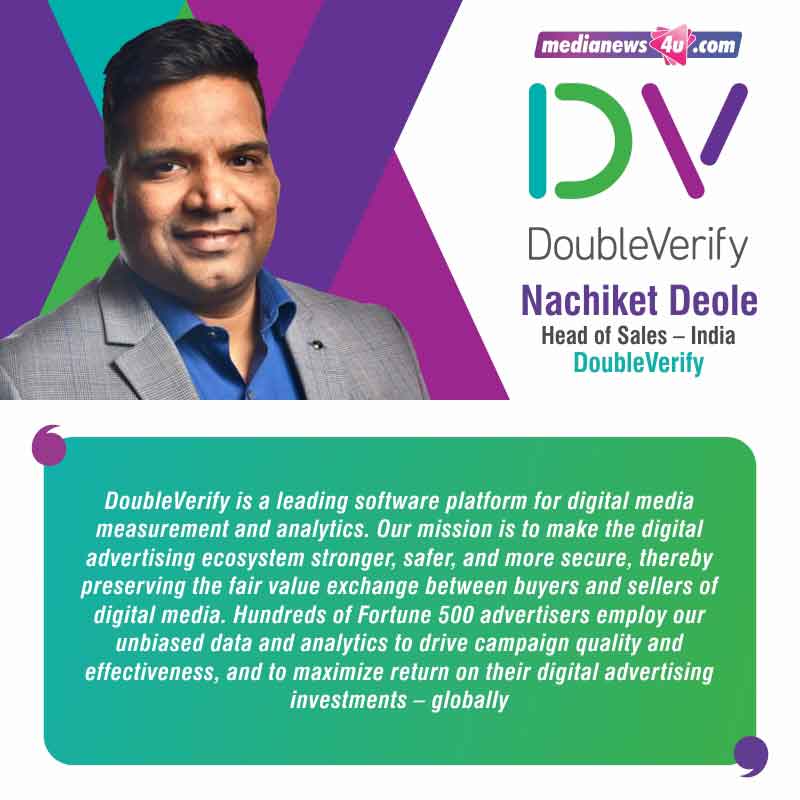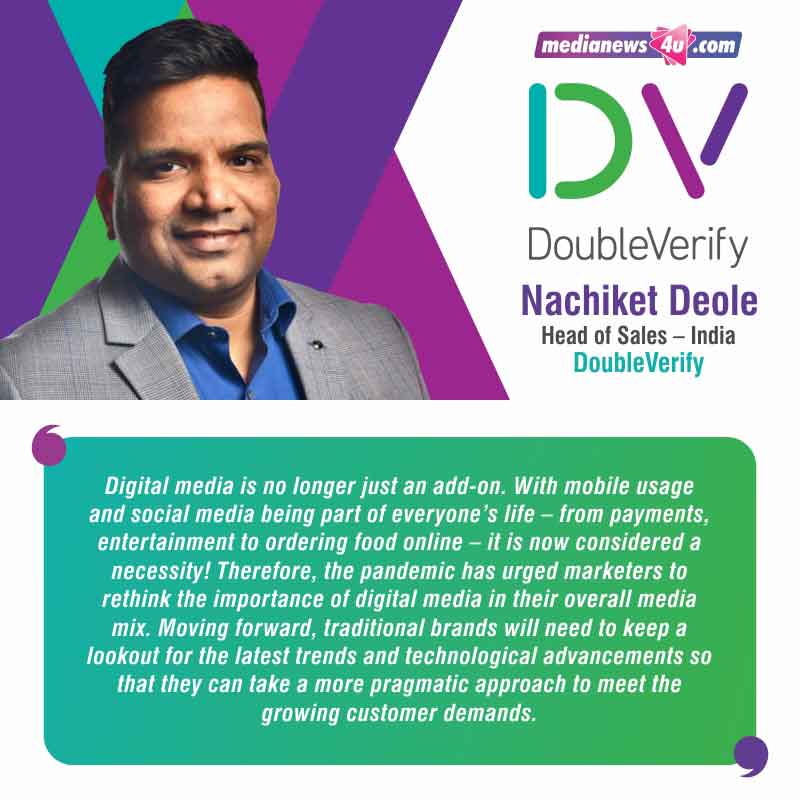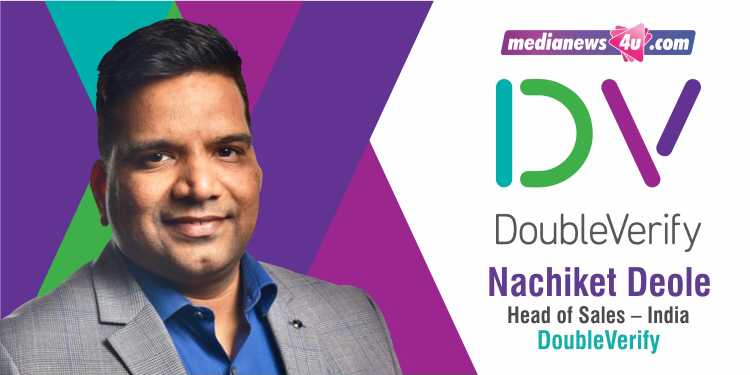DoubleVerify (DV) is a leading software platform for digital media measurement, data and analytics. DoubleVerify is a leading software platform for digital media measurement and analytics. Our mission is to make the digital advertising ecosystem stronger, safer and more secure, thereby preserving the fair value exchange between buyers and sellers of digital media. Hundreds of Fortune 500 advertisers employ our unbiased data and analytics to drive campaign quality and effectiveness, and to maximize return on their digital advertising investments – globally.
With e-commerce driving consumption amid the festive season and brands gearing up to cater to the pent-up demand – as a result of the covid restrictions, digital advertising too is likely to see an uptick as, advertisers tend to allot a large chunk of their advertising budget for this season. However, fraudsters have taken advantage of the increased traffic on retail websites and have proliferated several fake and malicious activities that have the potential to steal impressions. Additionally, given the shorter duration of festive season campaigns, it gives advertisers lesser time to review and optimize campaign performance, thereby putting an additional pressure on publishers to optimize their inventory to minimize risk and maximize performance.
Nachiket Deole, Head of Sales – India, DoubleVerify in an exclusive chat with Medianews4U, speaks on digital measurement, digital frauds and much more.
What is DoubleVerify, and when was it launched?
DoubleVerify is a leading software platform for digital media measurement and analytics. Our mission is to make the digital advertising ecosystem stronger, safer, and more secure, thereby preserving the fair value exchange between buyers and sellers of digital media. Hundreds of Fortune 500 advertisers employ our unbiased data and analytics to drive campaign quality and effectiveness, and to maximize return on their digital advertising investments – globally.

Launched in 2008, DV expanded its business operations in India in July 2020. And in April 2021, we made our debut on the New York Stock Exchange!
A plethora of platforms are now into digital measurement, data, and analytics. How different are you, and what is the USP of DV?
At DoubleVerify, we have over a decade of experience in building digital transparency and trust, protecting brands from advertising fraud and reputational risks, and driving campaign performance. Established at a time when concepts like digital marketing and performance measurement metrics were relatively new and unheard of, DoubleVerify became one of the first providers of digital verification in the industry. Today, we are proud to deliver our solutions to the world’s largest brands, platforms, and publishers here are some of our USPs:

DV Authentic Ad™ – It is a proprietary, MRC-accredited metric that ensures media quality. To be counted as Authentic, an ad must be fully viewed, by a real person, in a brand suitable environment, within the intended geography. DV is the only company accredited to measure and de-duplicates ad quality in this manner — enabling brands to use the DV Authentic Ad™ count as a defining, holistic KPI for campaign effectiveness.
Authentic Brand Suitability targeting (ABS) – ABS allows advertisers to create a customized set of brand suitability and fraud controls that works across multiple programmatic buying platforms and campaigns. By aligning pre-bid targeting with post-bid measurement and blocking, advertisers are able to significantly lower block rates, simplify administration, and drive superior performance.
DV Authentic Attention™ – It is the first privacy-friendly data solution in the market to provide near real-time, comprehensive data to drive campaign performance — from the impact of an ad’s presentation to key dimensions of consumer engagement. This rich dataset provides the basis for dynamic campaign optimization.
DV Pinnacle® – This is our platform for unified service and analytics. Through this, advertisers can access quality and performance data across devices and buying platforms, including social.
The past one and a half years have seen India going digital with a vengeance – this festive season, digital payments and online purchasing have surged. Have marketers and brands kept pace with their communication?
Online content consumption skyrocketed during the COVID-19 lockdown, accelerating the speed of digital media adoption and investments. According to a DV/Sapio report, on average, the time users spend consuming content on digital platforms per day has doubled – from 3 hours, 17 minutes, to an average of almost 7 hours. In order to keep up with the ‘Post Corona Consumer’ phase, brands have begun to prioritize digital advertising for effective communication – relying on their digital strategy more than ever.
Today, the advertising spend is skewed towards digital. How are traditional brands navigating this trend?
Digital media is no longer just an add-on. With mobile usage and social media being part of everyone’s life – from payments, entertainment to ordering food online – it is now considered a necessity! Therefore, the pandemic has urged marketers to rethink the importance of digital media in their overall media mix. Moving forward, traditional brands will need to keep a lookout for the latest trends and technological advancements so that they can take a more pragmatic approach to meet the growing customer demands.

What are the trends in India and globally in the new normal?
Below are a few trends that we have observed lately:
The need for privacy-friendly solutions in a cookieless world: Third-party cookies have been an integral part of online/digital marketing for over a decade, helping companies with several purposes – ranging from audience targeting, behavior tracking to remarketing, and much more. However, with the surge in digital content consumption, data privacy has become the top concern for consumers. The intent of the adoption of privacy-related laws such as the EU’s GDPR and ePrivacy Regulation and India’s own Personal Data Protection Bill is to allow consumers to make more informed decisions about their data and has led to the use of third-party cookies being phased out. From the perspective of digital advertising, this shift has come as an inevitable change. As such, marketers will need to invest in privacy-friendly performance solutions such as attention metrics and contextual targeting in a post-cookie world.
Increased demand for third-party verification tools: A recent Harris Poll and DoubleVerify poll revealed that nearly 90% of consumers feel that brands bear responsibility for ensuring their ads run beside content that is safe. The same study also found that over 67% of consumers’ loyalty to a brand will be affected if they viewed the brand’s digital ad adjacent to any false, objectionable, or inflammatory content. This is continuing to become a focal point as brands realize their reputation with consumers can be adversely affected by negative placements in media. Top brands across India are now deploying brand safe and brand suitable ad verification tools to ensure their digital ads are not placed next to content that is negative and not in line with their values.
As spend on gaming goes up, advertisers will demand verification: In-game advertising is, arguably, the next frontier of digital advertising. According to eMarketer, in Q2 2021, people spent 9.0 billion hours watching live streaming video game content around the world (excluding China). This is a significant increase from 3.8 billion hours in Q2 2019. This new high follows a 56.9% quarter-over-quarter jump in Q2 2020.
Advertisers know that there is a huge opportunity in getting in front of gaming audiences. But gaming is a complex, fragmented ecosystem. Users pick and choose their preferred environments, and marketers will want to understand how they can measure campaigns in those spaces. We’re likely to see more gaming companies adopt open measurement standards to help advertisers spend dollars with confidence. As advertisers invest in the gaming space, third-party verification providers will also need to partner with inventory holders and buying platforms to bring new measurement solutions to the category.
Additionally, in 2022, we’ll likely see a greater focus from large scale brand advertisers on making in and around game advertising a more standard part of their media buys. At the same time, publishers will make gaming inventory easier to buy. We should see console games; for example, move closer to the web and CTV model of dynamic ad insertion and measurement. As this happens, advertisers will be able to more easily join casual, console and other kinds of gaming together and align it to broader campaign goals. Advertisers and agencies jobs continue to increase in complexity. So, easier execution for operational teams, alignment to standard campaign and performance measurement for analytics teams and a more holistic view into gaming’s contribution to the media plan for investment teams, will help agencies and advertisers justify shifting dollars into the channel.


















